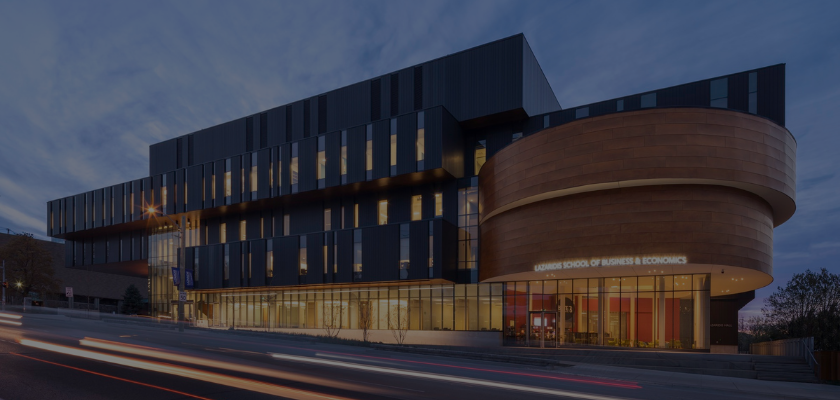Jennifer Ferfolja, Wilfred Laurier University & Portage CyberTech
“During the pandemic, that sense of community, while we are working remotely, […] the way people are coming together to solve problems and work through challenges, has been really quite impressive.”
When Jennifer Ferfolja, ICT manager at Wilfred Laurier, talks about the university, the first thing she mentions is the collaborative flow that runs through the establishment.
Jennifer notes that having a collaborative culture is more important than ever today. The challenges faced by large academic institutions call for the adoption of new technologies, but also a strong spirit of mutual support.
She counts herself lucky that at WLU, “everyone is adapting so quickly” to a world in constant flux.
With campuses in Waterloo, Brantford, Kitchener and Yellowknife and an office in China, how is WLU seamlessly and efficiently making the shift towards digital processes?
Supporting others in learning to adapt
Right away, Jennifer emphatically and energetically explains that her role in IT is to accompany people and “listen to the issues that they are experiencing.”
“People don’t like change. I don’t like change; no one likes change. But the outcome can be great.”
Change can be for the better, but it doesn’t happen on its own. It goes without saying that Jennifer's role is to advise the university on technology, but she must also take time to help people learn how to use it.
“Change is constant, and we have to keep working with it and not against it. It’s inevitable. When people come to us with issues or problems. I’m like: ‘Ok, let’s work on it.’”
Throughout her interventions with employees, Jennifer shows herself to be receptive, flexible and innovative. When a change occurs, it’s no longer seen as an obstacle, but as an ally in the making: a step in the direction to something better.
“The environment may have changed, the way we do things may have changed, but let’s work through changes.”
Thanks to Jennifer, Wilfred Laurier University isn’t just leveraging tools that keep pace with the digitization of society; the human processes in place ensure that they are successfully implemented.

When the pandemic brought everything to a halt in March 2020, a swarm of queries landed at the ICT department’s doorstep. How do we communicate? How do we teach? How do students attend classes? What do we have to do to keep the university running during a lockdown?
That’s when Wilfrid Laurier University showed its true colours.
“We could not have done any of this alone. We needed cross-functional teams, we needed people with different skills, from HR, to IT, to senior leadership, to the departments, faculties and students!”
Just imagine the magnitude of the challenge that Jennifer and her team were facing. They had to find and implement technologies in record time to distribute, design, communicate, approve, and gather information, for all the university's clientele, students, partners and employees.
One of the biggest challenges was finding a remote signature solution that could be used both internally and externally. Without it, the university would have been paralyzed.
“In a remote environment you don’t have your usual ways of contacting people [...].”
She and her team found ConsignO Cloud, a trusted electronic signature tool, that met the university’s high legal standards. And now, Wilfrid Laurier University signs all its contracts and legally binding documents using this e-signature process.
“It met our security requirements for our legal obligations.”
Jennifer adds that implementing it was easy, at a time when other tools were also being adopted. “People have been very receptive to it and adapted quickly. “Having that solution enabled us to continue doing our everyday processes.”

A flexible work culture
Other than technology itself, Jennifer mentions that the collaborative spirit that reigns at the university also flows into the relationship that employees have with each other and with those in leadership positions.
“We are very flexible in how we work. [...] We need to collaborate because it’s important. I think that is what helped us get to where we are.”
She’s not wrong. According to Forbes, the more a company has a traditional and hierarchical structure, the more the “experience of using their products and services will often feel equally opaque, complex and muddied.”
In Jennifer's opinion, digital solutions act as a remedy to this type of structure by creating communication channels and facilitating contact between employees and their leaders.
“We don’t need barriers between people. We just need to work together to make the organization better. Digital transformation allows for cross-functional work and teams interactions.”
That way, as soon as a problem arises, at any level, it is likely that it will be addressed and resolved. As a result, WLU is much quicker to respond when a problem develops.

Long-term solutions
While the pandemic compelled the institution to speed up its digital transition, Jennifer notes that the types of tools they adopted aren’t just alternative solutions. Some of them are here for good.
"The pandemic just pushed us forward really fast and we are going to have to keep that momentum going.”
Electronic signatures are a good example, she says. “The ability to have not only signers, but also reviewers […], has been very helpful.”
“We would have contracts […] and we would need multiple assistants, multiple VPs to sign off internally first and then it would go out to the vendor.”
She adds that the process was surprisingly effective at making stakeholders accountable and speeding up administrative processes.
“The system tells you where it is in the process. You get an email saying when it’s time to sign off on the agreement, and so on, to the next person. This has been helpful in making sure that the signing workflows happens without unnecessary delays.”
Technological solutions are good at filling human gaps, such as automatic backups or, in this case, monitoring workflows. At a minimum, they improve efficiency and communication by removing everyday issues of concern.
Jennifer openly admits that trusted electronic signatures, like many other electronic solutions, are here to stay. “It’s a no-brainer.”
“It meets that need, but it does it online and quicker!”
The university of tomorrow is now!
In the end, while the pandemic persuaded WLU to adopt new technological tools as a matter of urgency, Jennifer makes it clear: “We don’t think we’re going to go back to our traditional ways.” She adds that, instead, it’s time to prepare ourselves now for the new world of education.
“The challenge that we are going to have, if we look forward, is post-pandemic. [...] What does that world look like? How do we prepare for it? […] Some people in the classroom, some people learning remotely at the same time. How are we going to enable that?”
As a manager ahead of her time, Jennifer believes that, with technology “moving so fast paced these days,” her organization must act now to face the future.
“We have to keep moving to keep up.”
According to the University of Pennsylvania, people can be expected to return to university several times over the course of a lifetime and often regardless of their geographic location.
Jennifer notes that “The education world (…) is changing pretty rapidly right now.” New markets and disciplines in constant evolution already pose, and will continue to pose, many challenges for universities.
“We need to adapt to this new generation of learners and different types of learners that we did not anticipate. People are coming back to school or want to upgrade their skills. We need to adjust how we do our work and how we set things up to help these people.”
To illustrate her vision of the university of the future, Jennifer uses a simple example.
“Kids in elementary schools are growing up with tablets and they are very comfortable with technology. We need to anticipate that new generation!”
The democratization of knowledge via the web, the increasingly widespread use of coding and the availability of certain technological tools once reserved for advanced professions mean that future students “are coming in with some pre-knowledge that maybe past generations would have only gotten at university.”
“The ability to have a virtual workflow [...], the upcoming generation is used to that. They are going to sign their mortgage through an electronic signature solution.”
Wilfred Laurier University succeeded in continuing its operations during the pandemic; they will assuredly be able to meet the expectations of future students who are currently programming video games or watching Bollywood movies. Why? Because Jennifer’s preparing for it.
At the end of the day, maybe that's what it takes to successfully shift to digital, or at least, to successfully implement any institution-wide change. One, by ensuring that collaboration is at the heart of the process, and two, by making way for someone as bright minded as Jennifer who can intuit the future.
